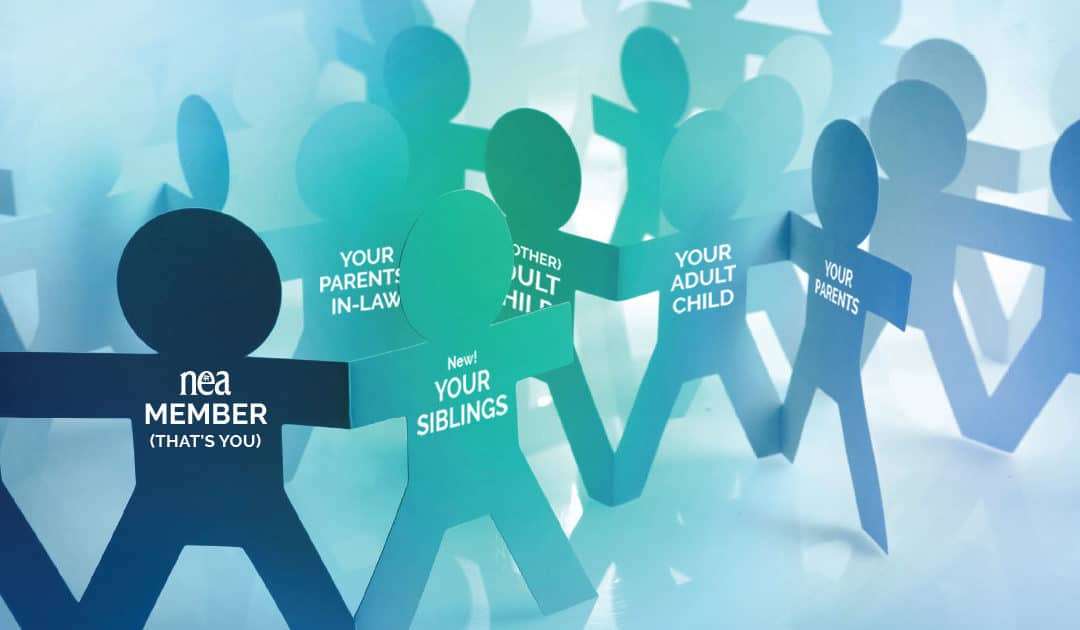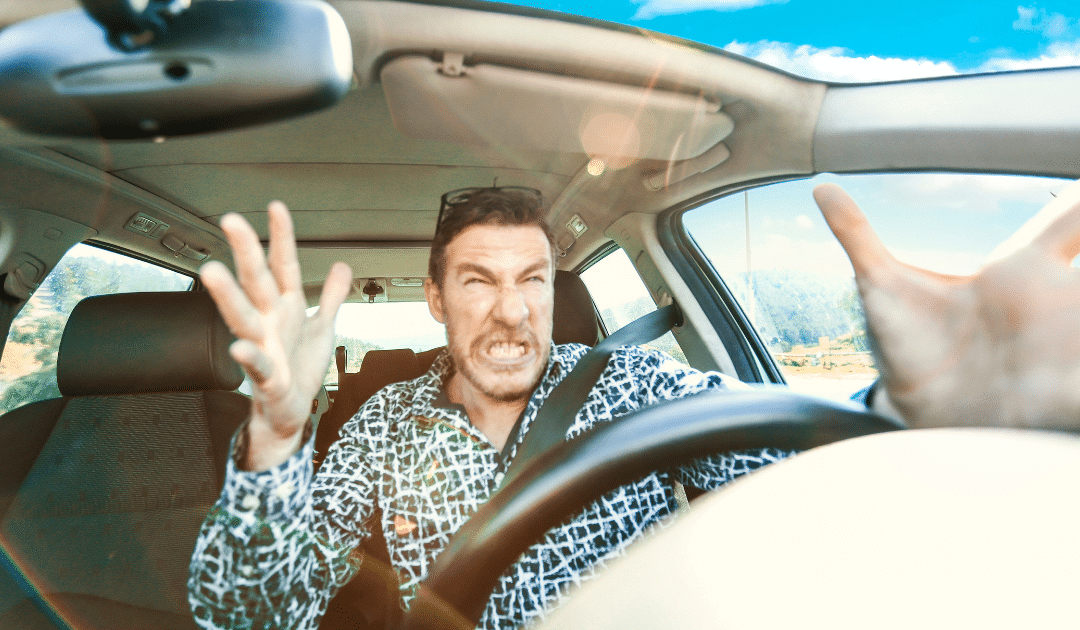
by California Casualty | In Your Community |
NEA Member Benefits recently added siblings to the list of family members eligible to access the NEA Auto and Home Insurance Program provided by California Casualty. Referred to as an NEA Member’s “Extended Family,” parents, in-laws, adult children, and now siblings can take advantage of the special rates, deep discounts, and personalized service available through the NEA Auto and Home Insurance Program.
California Casualty offers policyholders special benefits, such as:
-
- Rates good for a full year, not six months like many insurers offer
- Auto insurance that covers $500 for non-electronic items taken from your vehicle
- $0 deductible for accidents in a rental car
- Broad policy protection for anyone they allow to drive your vehicle
- Free ID defense
- Free pet injury coverage up to $1,000
- Holiday or summer skip payment options
- Exceptional towing and roadside assistance availability
Plus, as an NEA Member, you have more exclusive benefits, including:
-
- Waived/reduced deductible for collision or vandalism while parked on school property
- Educators excess liability coverage for protection in the classroom
- Fundraising coverage with $0 deductible for goods/funds valued up to $500 while under your care at school
- And more!
Tell your family (and colleagues) about the NEA Auto and Home Insurance Program. Members who switch see an average of $423 in savings.
This article is furnished by California Casualty, providing auto and home insurance to teachers, law enforcement officers, firefighters, and nurses. Get a quote at 1.800.800.9410 or www.calcas.com.

by California Casualty | Auto Insurance Info |
As more cyclists (of all ages) take to the road to enjoy the nice weather, now is a great time to brush up on the rules for safely sharing the streets.
Think of bikes as cars, but with fewer safety features. Road hazards such as potholes and debris may cause a cyclist to suddenly swerve, much like if they were driving a vehicle. And although riding on the right side of the lane is preferred for bike traffic, there may be the occasion when cyclists take to the center if road conditions require it.
Understanding cyclists and anticipating their next move will help you safely share the road. Here are some quick safety reminders on driving with cyclists this summer.
1. They have the right to “drive” in your lane, but they also need their space. Always give cyclists the right of way. Be sure to watch your speed compared to theirs. Pass only when there’s ample room (at least 3 feet between you and their bike) and while other vehicles are not approaching.
2. Look for bicyclists everywhere. Cyclists may not be riding where they should be or may be hard to see—especially in poorly lit conditions, including dusk/dawn/night and even in inclement weather.
3. Avoid turning in front of a bicyclist who is traveling on the road or sidewalk, often at an intersection or driveway. An oncoming cyclist may be traveling faster than you think. Drivers turning right on red should look to the right and behind to avoid hitting a bicyclist approaching from the right rear. Stop completely and look left-right-left and behind before turning right on red.
4. Completely stop at red lights or stop signs to let bikers pass or check for unseen bikers. Make eye contact with cyclists at intersections or crosswalks to acknowledge their presence and signal to let them know they are free to pass.
5. Don’t honk at someone on a bike. The noise could startle them, making them lose control of the bike they are riding. If it’s absolutely necessary, do so from a distance and make it a light tap.
6. Take extra precautions if you are sharing the road with children riding their bikes. They are smaller and harder to spot on the road, especially for drivers of bigger cars. Plus, these young bicyclists won’t have the same control over their bikes or know the rules of the road as mature riders.
7. Knowledge of common biking hand signals is a must. These include sticking the left arm straight out to indicate a left turn, holding the left arm up at a 90-degree angle to indicate a right turn, and pointing the left arm down at a 90-degree angle to indicate a stop or slowing down.
Taking extra precautions when you are behind the wheel and understanding a cyclist’s next move can help you avoid an accident. Use these tips this summer to help you both navigate the road ahead safely and seamlessly.
This article is furnished by California Casualty, providing auto and home insurance to educators, law enforcement officers, firefighters, and nurses. Get a quote at 1.866.704.8614 or www.calcas.com.

by California Casualty | Good to Know, Homeowners Insurance Info |
An attractive nuisance is anything on your property that is attractive to children, but in turn, could also put them in danger.
Examples of common backyard attractive nuisances include:
-
- Pools
- Hot tubs
- Trampolines
- Swingsets
- Firepits
- Fountains
- Treehouses
- Playgrounds
While these nuisances all serve as great ways for children to get outdoors and enjoy the summer sun, without the proper precautions, they can become problematic. In fact, attractive nuisances cause so many injuries when kids are out of school that summer is also known as “trauma season” among public health officials in the U.S. This is because unintentional deaths and serious injuries increase dramatically among children in the summertime.
Not only will these objects of entertainment put your own child at risk for serious or fatal injury, if one of their friends comes over to play one day and gets hurt on an attractive nuisance in your yard, you will be held liable for their injuries.
How to Minimize Your Risk
An attractive nuisance isn’t just limited to objects of entertainment like pools; they can also be anything that is on your property that draws curiosity like construction, weapons, grills, landscaping, lawn equipment, ponds, old cars, or appliances, etc.
This doesn’t mean that you will have to go and give all of your nuisances away, instead take the proper precautions to prevent the nuisances from causing harm.
Minimize the risk of an accident or injury by understanding what you have on your property that could be considered an attractive nuisance and take the necessary steps to safeguard against any future accidents.
-
- Keep your property clean. Pick up dangerous debris and clean up after projects that you have completed. If you have old items that you are using anymore, sell or get rid of them.
- Make dangerous items inaccessible. Keep dangerous weapons locked away in a safe, equipment, and vehicles in a garage or shed, and put a cover on pools, fire pits, grills, and hot tubs.
- Install a gate and lock system. If there is no way to make items in your yard inaccessible try installing a fence or locked gate with a no trespassing sign to help keep curious children out.
- Always supervise. If you have an attractive nuisance in your yard, never let your children or their friends play outside without adult supervision.
- Have adequate coverage. Make sure you have enough liability coverage with your homeowner’s insurance. Talk to your insurance agent and review your policy.
If you fail to minimize the risk of injury and a child in your neighborhood harms themselves (or worse) on your property, you may be subject to legal action. Read your local laws and use good judgment, if you feel like you have an item of concern in your backyard, use the steps above to help prevent an accident.
How an Attractive Nuisance Affects Your Insurance
Insurance agents look at your property to determine your home insurance rate. Certain features of your home or property could impact your rate because of their degree of danger. For instance, if you have an in-ground pool in your backyard you will likely have a higher rate because a pool increases the risk of danger.
When you speak to your home insurance agent you will need to disclose if you have any attractive nuisances on your property to protect you from getting future claims rejected, if an accident were to happen on your property.
Many people assume that their homeowner’s insurance will provide them the protection they need if someone gets injured at their home, but this isn’t always true. If you have an attractive nuisance, protect yourself and your family, talk to your insurance agent and ask about increasing your liability protection or about adding a personal umbrella policy to your homeowner’s insurance.
This article is furnished by California Casualty, providing auto and home insurance to educators, law enforcement officers, firefighters, and nurses. Get a quote at 1.866.704.8614 or www.calcas.com.

by California Casualty | Auto Insurance Info |
Breaking down on a busy street or highway can be dangerous. Roadside assistance is an add-on coverage that’s at your service 24/7 to help you get back on the road safely if you are left stranded due to an accident or car problems.
Whether you run out of gas, a tire blows out, or you are experiencing any other kind of car or engine trouble, roadside assistance has your back. Instead of spending money on an expensive tow, you can rest assured knowing that you are covered when you choose to add it on to your auto insurance policy.
Plus, when you add roadside assistance to your coverage you will pay as little as around $1 a month. This is a coverage you can’t afford to NOT have!
What Will Roadside Assistance Cover?
When you add- on Express Road Service to your California Casualty auto policy, you will be covered if you need assistance with
- Jump starts
- Lockouts
- Tire repair or change
- Gas, oil, and water delivery
- Towing to the nearest repair facility
And you won’t even have to remember to make additional payments to keep roadside assistance. Your cost of coverage will be rolled into your monthly premium to help make payments more convenient for you.
Talk to your insurance agent to understand what is covered. Ask about additional services and the exclusions and limitations when adding roadside assistance to your policy.
Why Do I Need It?
Roadside assistance offers you fast, reliable service available to you when you need it most. Here’s why everyone should add this coverage on to their auto insurance policy.
- Affordability. With annual prices as low as $1 dollar a month, you won’t even feel like you’re paying for additional coverage. Rates at these prices can’t be beaten even by other big-name clubs or associations like AAA.
- 24/7 hour service. No matter if your car breaks down at 12 a.m. or 12 p.m. you will never be stranded, roadside assistance will come to you at any time of day or night to help service or tow your vehicle.
- Peace of mind. If your car is older, or starts having mechanical issues you can have peace of mind driving to your destination (no matter how far) knowing that roadside assistance is a phone call away.
- Towing. Car tows are very common and can be costly if you do not pay for roadside assistance. The average cost for a car tow without roadside coverage is $109.
- Teen Driver Safety. If your family has a teen driver on the road, as parents you can breathe easier when handing over the keys knowing your young driver can call roadside assistance for help if the unexpected were to happen.
If you have an auto policy without roadside assistance, what are you waiting for? Call and add-on this cheap and essential coverage today at: 1.800.800.9410
This article is furnished by California Casualty, providing auto and home insurance to educators, law enforcement officers, firefighters, and nurses. Get a quote at 1.866.704.8614 or www.calcas.com.

by California Casualty | Auto Insurance Info |
No one likes getting cut off in traffic or the feeling of a tailgater trailing closely behind. When those feelings cross the line from irritation to retaliatory action, that’s road rage. Road rage, as most of us know, is significant anger and/or aggression directed toward one driver by another. It can be in the form of insults, gestures, physical attacks, and even dangerous driving maneuvers that can run you off the road.
Road rage is a form of distracted driving that can lead to collisions, injuries, and even death. Knowing how to keep your cool behind the wheel, and what to do if you are targeted by road rage, will help prevent accidents and bring you safely back home.
Road rage is more common than you think.
The majority of American drivers – almost 80 percent – admitted to aggressive driving or feelings of road rage in 2019, according to the AAA Foundation. The Foundation’s analysis of 10,000+ road rage incidents over 7 years revealed 12,610 injuries and 218 deaths. Road rage is a factor in more than half of all fatal collisions.
Know the causes of road rage.
There are many triggers for road rage. Most often, aggressive behavior stems from angry emotions that get out of hand due to situational circumstances, such as traffic conditions, or the driver’s own mental state.
-
- Road rage can be a habitual or learned behavior. Drivers may be in the habit of yelling at cars that cut them off. They may perceive the behavior as normal.
-
- Cars provide a layer of anonymity that makes it easy to “rage.” In road rage incidents, drivers do not see another person; they see a vehicle. As a result, they don’t think of the individual/family they will be affecting when they lash out at another driver.
-
- Drivers who “rage” may have a disregard for the law. They may be speeders and tailgaters, and have the perception that they are above the law.
-
- Traffic congestion and delays can cause road rage. Drivers who are running late are more likely to get upset during heavy traffic conditions.
-
- Distracted driving may prompt road rage. Drivers on their cell phones could contribute to road rage reactions when they don’t move as planned through traffic.
Know how to prevent road rage.
You don’t have to be an aggressive driver to experience road rage. It can happen to anyone! Here are some ways to stay cool behind the wheel.
-
- Make sure that you’re well-rested and ready to drive. Get enough sleep. Limit alcohol intake. If you’ll be traveling long distances, take time for regular stops to recharge.
-
- Leave plenty of time for your trip. Drivers who leave early are less likely to be stressed about traffic congestion or angry at other drivers who may delay the journey.
-
- Play soothing music. Set the mood for a relaxing trip with a soothing soundtrack.
-
- Don’t honk or yell. Raising your voice and honking your horn only serves to escalate a situation.
-
- Don’t tailgate. Leaving enough space between you and other cars helps prevent incidents that can lead to road rage.
-
- Remember to show some empathy. Everyone has a bad day now and again. Give your fellow driver the benefit of the doubt. He/she may not have meant to cut you off.
Know what to do If you’re a victim of road rage.
It can be frightening if you are the target of road rage. The most important thing to remember is to keep your cool, and follow these suggestions.
-
- Don’t return gestures. Don’t make eye contact. Engaging with an angry driver only escalates the potential for road rage. Keep your eyes on the road and, if possible, distance yourself from aggressive drivers.
-
- If you’re being tailgated, switch lanes. Try to move out of range of the other driver. Do not slam on the brakes to get them to back off. That tactic is dangerous.
-
- Stay behind an aggressive driver. Being in front of an aggressive driver puts you in their field of vision. Moving behind, and lengthening your distance, can help.
-
- Don’t pull over and stop. Unless you are stopping at a stoplight or stop sign, do not stop. Stopping your car is the precursor to engaging with the other driver—something that you do not want to do.
-
- If the harassment continues, pull into a police station. There may be times when you cannot shake the aggressive driver. In those cases, the best tactic is to head to the nearest police station.
Look out for road rage during these high-travel months.
Any time there is traffic and congestion on the roads is a time that could trigger road rage. The summer months, and especially August, have been shown to be prone to incidents of road rage. Similarly, holiday travel in December with its associated congestion, traffic delays, and inclement weather, can produce the conditions ripe for road rage.
Plan your travel accordingly and follow these tips to help keep you and your family safe.
Safe travels.
This article is furnished by California Casualty, providing auto and home insurance to educators, law enforcement officers, firefighters, and nurses. Get a quote at 1.866.704.8614 or www.calcas.com.





